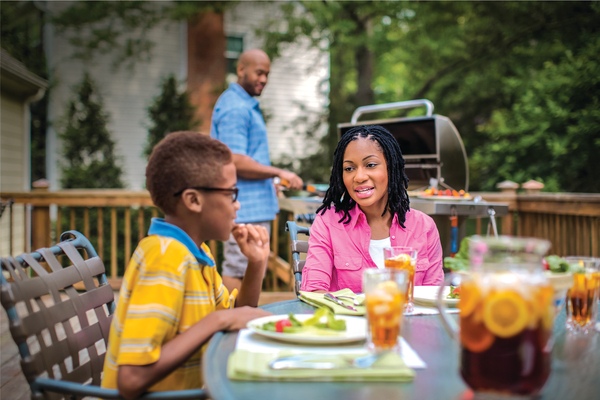How to Use Your Propane Grill the Safe Way

With grilling season upon us, it’s important to know how to properly use your grill so your backyard fun (and dinner) isn’t ruined. While propane grills are popular and convenient, they must be used in a safe manner so that the food isn’t burned, and you aren’t making an unexpected trip to the ER or calling the fire department. While that may sound extreme, according to the National Fire Protection Association, nearly 20,000 people are admitted to the emergency room per year because of grill related mishaps! NFPA – Grilling safety. Check out our tips below to make your grilling experience enjoyable, safe and delicious!
Location, Location, Location
This popular phrase from house hunting can be applied to your propane grill. Before you try to make your first gourmet feast, you must make sure your grill is in a safe location. A safe spot for your grill should be:
- Outdoors (never ever grill in an enclosed space like a garage or even a carport because grills let off carbon monoxide fumes)
- On a flat, even surface
- At least five feet away from your home, your outdoor furniture, landscaping and trees.
Before You Use your Propane Grill
Everyone is excited to grill their first meal of the season, but before you fire the grill up, you should thoroughly clean and inspect the grill. Make sure all parts are in working order–that includes your propane cylinder. Make sure it is free from dents, scratches and rust, as these can be signs of a possible leak. You can check for propane leaks by using warm, soapy water on the cylinder. Any sign of expanding bubbles indicates a leak (Safe Grilling Tips | PERC (propane.com). If your cylinder shows signs of a leak or damage, do not use it. And never, try to repair a damaged cylinder yourself—leave that to a professional. Additionally, you should make sure the cylinder is full of propane.
Using Your Propane Grill Safely
The first step in safely using your grill is to read the manual! It sounds obvious, but it’s best to make sure you really know how to operate your propane grill before you attempt to light it. Next, gather everything you need to make your meal, including a fire extinguisher for safety precautions. It’s important to make sure you have all of your ingredients and grilling tools before you start cooking because you should never leave a lit grill unattended.
Now, you’re ready to cook! Before you light the grill, open the lid and make sure the propane is switched on. Light the grill using the igniters. If the grill fails to ignite right away, turn the igniters off, leave the lid open, and wait fifteen minutes before trying again. Never use any accelerants like gasoline or kerosene to help your grill ignite. They are major fire hazards!
Once the grill is lit and your food is cooking, there are some additional safety precautions to keep in mind:
- Stay nearby the grill at all times
- Keep children and pets away from a lit grill
- Do not store extra propane canisters next to the grill or any heat source
- Do not store extra propane cylinders indoors
- Do not smoke near the grill or extra propane cylinders
- Keep the lid closed as much as possible to prevent flare-ups
- Use your nose—if you smell rotten eggs, you have a propane leak and need to turn the grill and propane off immediately.
Safety Steps for When the Grilling Is Finished
Now that you’ve finished grilling your meal, it’s time to turn off the grill and the propane. Both the propane valve and the grill should always be turned off when the grill is not in use. Then you can safely clean the racks with a grill brush while the grill is still warm. This prevents leftover food and bacteria from transferring to the next meal you cook and also prevents flare-ups. (Most flare-ups are caused by leftover grease).
Now that your grill is clean and stored safely, you can relax until the next time you fire it up! To learn more about how Superior Plus Propane can help you have a wonderful grilling experience all summer long, please visit us at www.superiorpluspropane.com. Happy, SAFE grilling!
"*" indicates required fields


